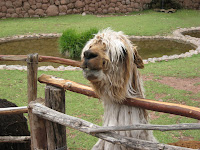
 Mining and metal works generates most of Peru's GDP. Peru is one of the top three producers of silver in the world. You see this in the churches, which have ornate silver plated alters. You see silver in the numerous jewelry stands sprinkled through out the markets. Cusco, the rainbow city, had a particularly special way of inlaying geometric patterns of semi-precious stones like turquiose, mother of
Mining and metal works generates most of Peru's GDP. Peru is one of the top three producers of silver in the world. You see this in the churches, which have ornate silver plated alters. You see silver in the numerous jewelry stands sprinkled through out the markets. Cusco, the rainbow city, had a particularly special way of inlaying geometric patterns of semi-precious stones like turquiose, mother of  pearl, purple Spondylus and lapis lazuli in silver.
pearl, purple Spondylus and lapis lazuli in silver.

Textiles are also key to the Peruvian economy, particularly alpaca. Our tour guide took us to a shop which helped us identify the different types of alpaca - baby alpaca, alpaca with silk, alpaca with wool and "maybe" alpaca. Besides being a bit of a sales pitch, this little lesson helped us be less like lambs among the vendor-wolves on the street, when we were shopping for family and friends.
The next day we were taken to an alpaca farm, where we were given lessons in the different types of alpacas, how to differentiate an alpaca from a llama (I kept mixing them up). We got to feed the herd. It was as exciting as the petting zoo when you were three.




Then, our guide showed us how the sheared wool would be boiled to give it color, before being spun into yarn. (This Finally, we saw the woman weaving. Yes. It was a bit of a-put-together-Peruvian-history production but it was interesting. The alpacas were so amusing with their wool flopped over their wild eyes. It gave them an air of comic aloofness.




While some of what we were shown was pure tourist show, there were elements of that show which infiltrate the daily life of a Peruvian family. They weave. They actually do use their own garments and blankets. They embrace bright colors, which lend a sense of perpetual fiesta to their world.


